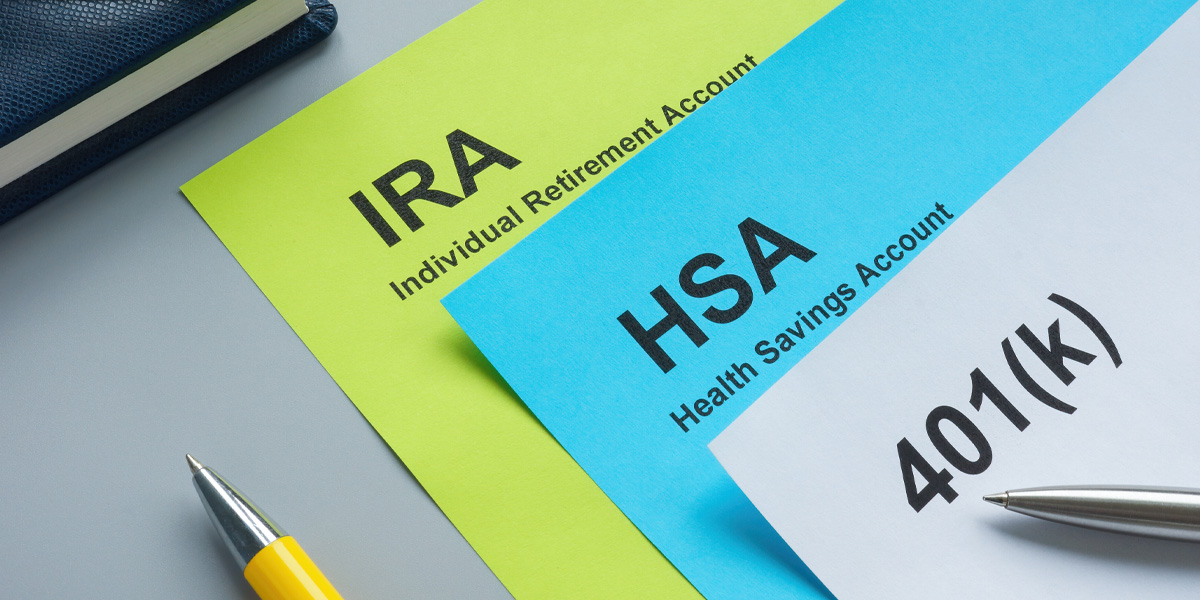
When you think of your future, especially retirement planning, your first thought might be a 401(k) plan. While this is a common component of an employee benefits package, employers may also offer a health savings account (HSA) option. Both have immense value for future expense planning pre-and post-retirement. Let’s walk through the basics of each and discuss how these options can help you save money in retirement.
The 401(k) basics
A 401(k) is an employer-sponsored retirement plan in which you contribute a portion of your earnings each year up to a specific amount. 401(k) plans are the nation’s primary employer-sponsored savings vehicle. They are one of the most powerful savings vehicles available today.
401(k) plans have the following features:
- Employees can make either pre-tax or Roth contributions.
- Generally speaking, pre-tax contributions reduce taxable income inthe year of the contribution. Those contributions are taxable when used at retirement.
- Roth contributions are made after tax today, meaning there are no tax advantages in the year of the contribution. However, Roth contributions and all earnings are most often tax-free when used at retirement.
- Generally speaking, pre-tax contributions reduce taxable income in the year of the contribution. Those contributions are taxable when used at retirement.
- Contribution limits are relatively high. In 2023 employees can contribute $22,500. Employees over the age of 50 can contribute an additional $7,500.
- Within the framework of the investments your employer offers, you decide how you want to invest your retirement savings. For those that are unable, unwilling, or not interested in deciding how to invest, most well-designed 401(k) plans will have funds and/or services that will make the investment decision for you and provide free advice. Investments available range from conservative to aggressive, to satisfy the investment needs of a wide-range of employee demographics.
- Many 401(k) plans have matching contributions provided by your employer. While these contributions vary, this is free money that you get simply by participating in the 401(k) plan. The immediate “return” of contributing to your 401(k) plan from the match could be as high as 50-100%. This component is unlike any other savings program that you can do on your own.
- You take advantage of long-term compound growth on your account for your contributions and the employer match. For example, a 30-year-old with a $40,000 annual salary, that contributes 6% of pay and receives a 3% match from their employer will have more than $760,000 when they turn 65. (This assumes a 7% rate of return and a 3% annual contribution increase.)
- Some plans have a loan feature. This allows you to access your cash before retirement. You pay yourself back via payroll deduction through your employer. If you leave your employer and don’t pay back the loan, the outstanding balance will be subject to taxes and, if you are under the age of 59 ½, with a 10% penalty.
- 401(k) plan contributions and matches are portable. You can take them to your new employer, if you make a job change, or roll them to an Individual Retirement account (IRA). Generally speaking, these two options are done without a taxable event. If you take the funds in cash you will pay state and federal income tax, along with an additional 10% penalty if you are under age 59 ½.
- 401(k) contributions and matches offer protection from creditors, including the IRS, in some cases.
The HSA basics
A health savings account (HSA) is not strictly a retirement savings plan. It’s a savings account meant to help cover health-related expenses. Think of it as an extra bank account like a checking or traditional savings account, but with tax benefits. The money put into your HSA account goes in tax-free.
HSA’s are only available to employees that use a high-deductible health plan (HDHP). For example, this is any plan with a deductible of at least $1,400 for an individual and $2,800 for a family.
Saving through an HSA has the following advantages:
- Contributions made to an HSA are made on a pre-tax basis meaning it reduces your taxable income, also lowering your tax liability.
- Contributions grow tax-free and belong to the employee for life.
- When the funds are used for medical expenses, the contributions and earnings come out tax-free making them triple tax-free. Pre-tax contribution, grows tax-free, and used tax-free.
- Generally speaking, you can invest your funds in an array of investment options similar to a 401(k).
- Unlike a Flexible Spending Account (FSA), contributions made to an HSA are never forfeited.
- The maximum contribution to an HSA in 2023 is $3,850 for an individual and $7,750 for a family. If you are over age 55 you can contribute an additional $1,000.
- Withdrawals can be used for nonmedical expenses after age 65 without penalties. You would be taxed at ordinary income tax rates.
- Like an IRA or 401(k),you can designate a beneficiary.
- You can maximize your HSA by not taking withdrawals (so the amount can accumulate) and contribute as much as you can (to the annual limits) into your account. Once you retire, you can use your account to pay for qualified medical expenses, which tend to be higher after retirement. These funds are yours for life and do not expire, even after you are no longer with your current employer.
What do 401(k) plans and HSA’s have in common?
- Both have contribution limits (how much you can put in each year).
- Your employer can contribute to your 401(k) and your HSA.
- Both allow pre-tax contributions.
- However, withdrawals from 401(k)s are taxed while withdrawals from HSAs are tax-free (if used for qualified medical expenses).
- However, withdrawals from 401(k)s are taxed while withdrawals from HSAs are tax-free (if used for qualified medical expenses).
- Both have the ability to invest.
Now what?
Now that you know your options, what is the best one to pick? Well, the good news is that you don’t have to choose, you can save with both! By using both, you can set yourself up for a more financially secure retirement, but it’s important to select what the best option is for you, your lifestyle, and your family’s needs.
You may certainly have more questions now after learning about your retirement savings options. Most employers offer free onsite consultations with your retirement consultation firm. Take advantage of those sessions to learn how you can invest for your future.
Your employer may also host an HSA advisor onsite once or twice a year. Be sure to take advantage of that opportunity, as well, to see how you can save for future health expenses and utilize your money the best way possible.
And, don’t forget about your HR representatives. They are also a resource to help you understand and maximize your options, learn about educational opportunities, and to explain what is available in your employee benefits package.
Palmer Retirement Consulting
6714 Pointe Inverness Way, Suite 100
Fort Wayne, IN 46804
Website: https://www.palmerrc.com
Phone number: 260-969-3940
Securities and advisory services offered through Commonwealth Financial Network®, Member FINRA/SIPC, a Registered Investment Adviser. Fixed insurance products and services offered through Palmer Retirement Consulting or CES Insurance Agency.



